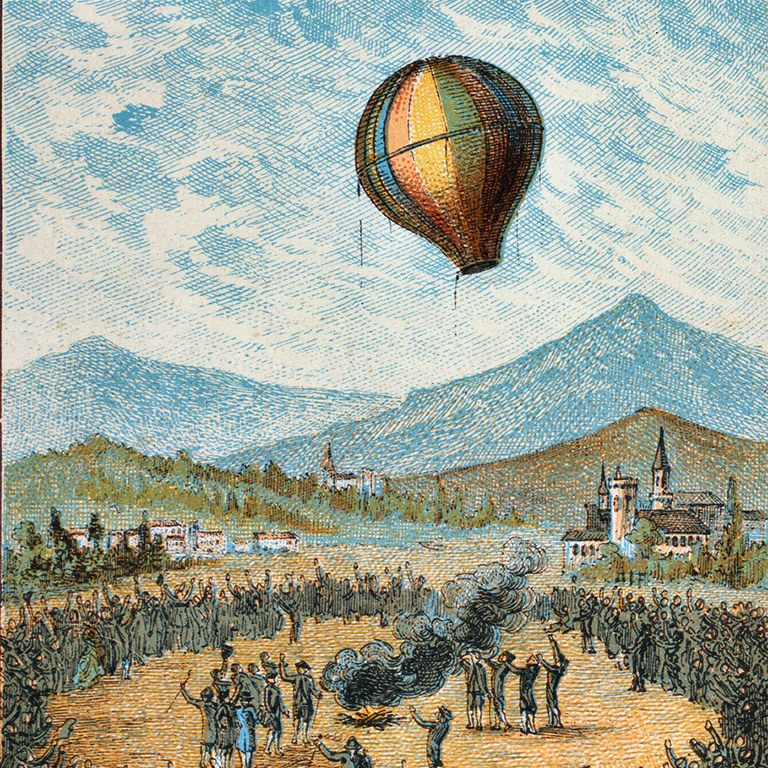The progress, how she is made

First public demonstration of a hot air balloon in Annonay, France, June 4, 1783. Detail from a set of cards “The Dream of Flight,” Library of Congress, public domain
Two hundred thirty-three years ago today, the Montgolfier brothers made the first public demonstration of their invention, the hot air balloon. Just as with the first space flights, the first balloon flights were unmanned, and though humans would begin to take flight within the year, test animals–in this case a duck, a rooster and a sheep–would precede the first human, and the first man would be launched before the first woman. That honor fell to Élisabeth Thible who, dressed as the Goddess Minerva, sang opera from the precincts of the air on this day in 1784. This was, after all, France.
But just as the German scientist Werner von Braun, designer of the rockets of the early space program, first built the V-2 war rocket that devastated parts of London during WWII, the Montgolfier brothers had military applications in mind, too.
As the story goes, Joseph Montgolfier was gazing into a fire one night in 1782 in Avignon, watching embers rise in the smoke. He theorized that the smoke contained a gas (which he modestly named Montgolfier Gas), and that gas possessed a quality to lift objects upward, (which, funnily enough, he dubbed “levity”). His first practical thought was how this quality could be used to lift troops for an aerial assault on the unscalable heights of the British fortress of Gibraltar. Inventors apparently had a thing for attacking the British.
It’s amazing to me how often the animating force behind scientific progress is actual animosity. This message itself comes to you via the Internet, whose genesis as DARPANet in the 1960s was a distributed network of computers that could maintain communications no matter how many of its individual units were destroyed in nuclear Armageddon.
Think how different the world might be if the Montgolfiers had invented the balloon simply because Joseph looked into the fire one night and had a vision of a diva dressed as a goddess singing from the air above an admiring crowd of Parisians, or if the Internet was born out of an overpowering desire to share cat videos. In the end, though, maybe no difference at all. Von Braun dreamed of flying to the moon long before he built the first V-2.
Tags: listeningpost





.png)


Here’s a fun idea.
Maybe the first thought of using air power in war goes all the way back to people wishing they could attack an opponent in the way seagulls and other birds can defend their nests.
I think it is safe to say that it was air power that was the deciding factor in WW II and it has been the reluctance to use air power ever since that has resulted in the US not really winning anything since.
I think maybe there’s a flip side to your thought; Imagine the vast cost to the nations of the world of the “Cold War”. Imagine what COULD have been done with that treasure if the superpowers had decided not to cooperate with the vendors of war for fifty years. Flying cars, moving sidewalks, and vacation homes on the moon come to mind of course, but what about more realistic things like mass transit, good housing, and a clean environment, or more philosophical ideas like universal health, wealth, and freedom.
The purveyors of death have sold humanity a bill of unwanted goods. They have concentrated the worlds wealth into the fewest greedy hands, and tread upon the lives of the rest of us…all while convincing us that it was all for the best.
Some of the worlds greatest inventions have yet to see their day.
Pete, Wherefore did you come up with the concept that: “air power that was the deciding factor in WW II and it has been the reluctance to use air power ever since that has resulted in the US not really winning anything since”?
A few facts for you to mull over:
During World War Two, United States aircraft dropped about 1.6 million tons of bombs in the European theater and approximately 500,000 tons in the Pacific theater plus an undisclosed tonnage of firebombs but likely nearly the same as the HE bombs since nearly every city in Japan was burned down.
During the Korean War of 1950-53, the U.S. dropped 635,000 tons of bombs and 32,000 tons of napalm
From 1961 to 1972, American aircraft dropped approximately one million tons of bombs on North Viet Nam, and approximately 4 million tons of bombs, 400,000 tons of napalm, and 19 million gallons of herbicides on South Viet Nam (and I was told I was sent over to help the South Vietnamese)
From 1964 to 1973 the US dropped an estimated 2 million tons of bombs on Laos
From 1965 to 1973 the US dropped an estimated 2.8 million tons of bombs on Cambodia
In 1991 in a single 40 day carpet bombing campaign the US dropped about 90,000 tons of bombs on the Iraqi Army in preparations for US ground forces to sweep them out of Kuwait.
Pete,
Check out this article:
https://www.washingtonpost.com/news/checkpoint/wp/2016/06/06/the-little-known-d-day-operation-that-accidentally-killed-more-than-100-u-s-troops/?tid=pm_world_pop_b